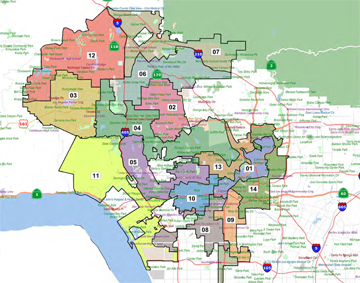Listen to an audio story from Annenberg Radio News:
After an eight-hour meeting, The Los Angeles City Council Redistricting Commission (LACCRC) approved a “Final Map Recommendation” just before midnight Wednesday on a vote of 16 to 5.
Los Angeles City Council Districts 8 and 9 will suffer dramatic changes to their borders under the newly approved district maps. Both will lose neighborhoods that are the economic engines of their districts.
CD-9, Jan Perry’s district, will lose its downtown constituency. CD-8, Parks’ district, will lose Leimert Park, a hub of black culture and commerce, and Baldwin Hills, a primarily black, middle-class neighborhood.
Without these neighborhoods, Districts 8 and 9 will be among the poorest of all LA City Council districts.
Also, the University of Southern California will be moved from CD-8 to CD-9. Why? Councilman Parks said he couldn’t identify a single community member who asked for that change, saying, “What I thought was amazing was that no one had come to the commission from either the 8th or the 9th district that live in that area or stakeholders saying that that should be moved”.
In fact, Parks accused the commission of drawing the maps before getting any community input:
“The real meetings were in secret. They just kind of placated the public by showing up and discussing or letting people talk.”
The Redistricting Commission’s website says there would be “at least 20 public hearings.” So far, 15 have been held during January and February of this year. Members of the public have also been able to submit their own maps via a form on the Commission’s website.
But the maps that were produced at the beginning of the redistricting process have not changed very much since then and now, despite citizen submissions and the public meetings. In Parks’ district, there were three meetings.
“They decided the maps were worthy of more weight than the public comment that was overwhelming in three meetings that said ‘Leave the 8th District alone.’”
Both Parks and Perry have said they think it’s payback because they didn’t support 10th Council District Representive Herb Wesson’s bid for City Council President. Said Parks, when asked about the allegation, “I”m too old to be punished. The issue is they’re punishing people that don’t need to be punished. So if their goal is to punish the community…These lines will be in place for 10 years. They’ve created two districts, the 8th and the 9th, with no resources and a bunch of poor people.”
Wesson, who won his bid for City Council President, stated in a recent LA Times article, that he has no personal motives for the redistricting moves. His press secretary, Edward Johnson, said he had no official comment.
Parks and Perry have pledged to file a lawsuit under the Voting Rights Act. The lawsuit will allege that the redistricting process failed to adequately incorporated community input. It will also claim that the districts are being re-drawn along racial lines, which is prohibited under the VRA unless studies are conducted which prove that voting is so strictly polarized by race that elections are not competitive.
The Redistricting Commisson will hold another meeting on February 29, 2012. Final approval is slated for March 1.
The new map is expected to be available for viewing on the LACCRC website by February 27th.









 After what turned into a nine-hour-long meeting on Wednesday, the Los Angeles Redistricting Commission has moved one step closer to solidifying major changes to the city’s council districts, including those in South Los Angeles.
After what turned into a nine-hour-long meeting on Wednesday, the Los Angeles Redistricting Commission has moved one step closer to solidifying major changes to the city’s council districts, including those in South Los Angeles.




